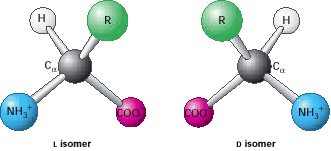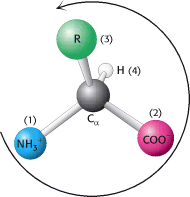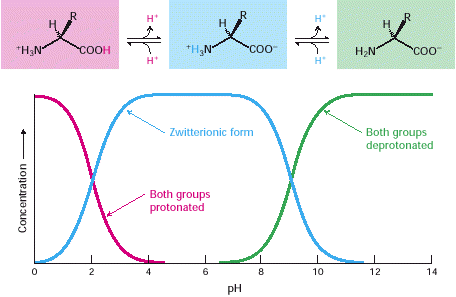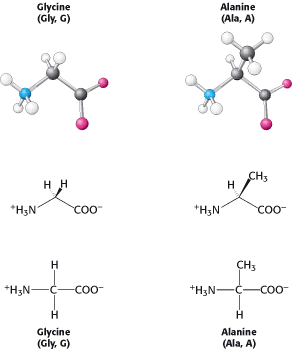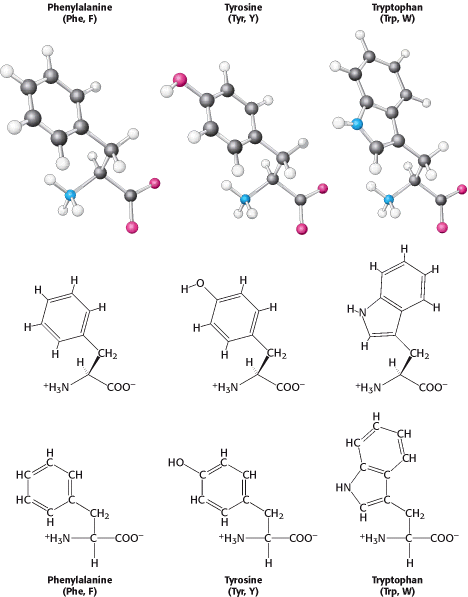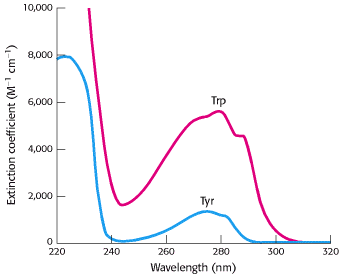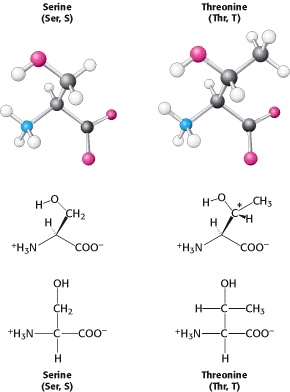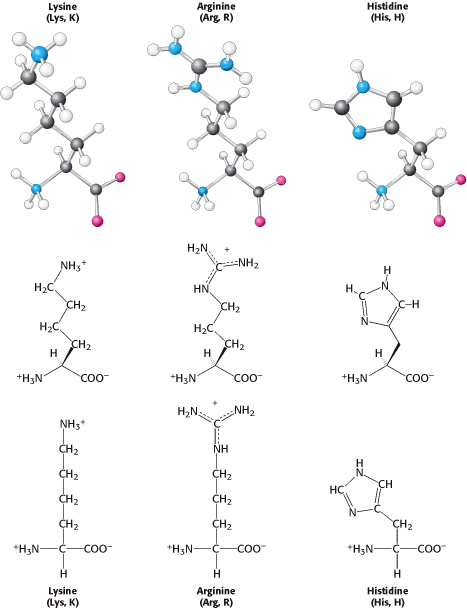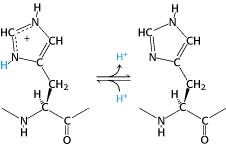3.1. Proteins Are Built from a Repertoire of 20 Amino Acids Amino acids are the building blocks of proteins. An α-amino acid consists of a central carbon atom, called the α carbon, linked to an amino group, a carboxylic acid group, a hydrogen atom, and a distinctive R group. The R group is often referred to as the side chain. With four different groups connected to the tetrahedral α-carbon atom, α-amino acids are chiral; the two mirror-image forms are called the l isomer and the d isomer (Figure 3.4).
Notation for distinguishing stereoisomers— The four different substituents of an asymmetric carbon atom are assigned a priority according to atomic number. The lowest-priority substituent, often hydrogen, is pointed away from the viewer. The configuration about the carbon is called S, from the Latin sinis-ter for “left,” if the progression from the highest to the lowest priority is counterclockwise. The configuration is called R, from the Latin rectus for “right,” if the progression is clockwise.
Only l amino acids are constituents of proteins. For almost all amino acids, the l isomer has S (rather than R) absolute configuration (Figure 3.5).
Although considerable effort has gone into understanding why amino acids in proteins have this absolute configuration, no satisfactory explanation has been arrived at. It seems plausible that the selection of l over d was arbitrary but, once made, was fixed early in evolutionary history.
Amino acids in solution at neutral pH exist predominantly as dipolar ions (also called zwitterions). In the dipolar form, the amino group is protonated (-NH3+) and the carboxyl group is deprotonated (-COO-). The ionization state of an amino acid varies with pH (Figure 3.6).
In acid solution (e.g., pH 1), the amino group is protonated (-NH3+) and the carboxyl group is not dissociated (-COOH). As the pH is raised, the carboxylic acid is the first group to give up a proton, inasmuch as its pKa is near 2. The dipolar form persists until the pH approaches 9, when the protonated amino group loses a proton. For a review of acid-base concepts and pH, see the appendix to this chapter. Twenty kinds of side chains varying in size, shape, charge, hydrogen-bonding capacity, hydrophobic character, and chemical reactivity are commonly found in proteins. Indeed, all proteins in all species—bacterial, archaeal, and eukaryotic—are constructed from the same set of 20 amino acids. This fundamental alphabet of proteins is several billion years old. The remarkable range of functions mediated by proteins results from the diversity and versatility of these 20 building blocks. Understanding how this alphabet is used to create the intricate three-dimensional structures that enable proteins to carry out so many biological processes is an exciting area of biochemistry and one that we will return to in Section 3.6.
Let us look at this set of amino acids. The simplest one is glycine, which has just a hydrogen atom as its side chain. With two hydrogen atoms bonded to the α-carbon atom, glycine is unique in being achiral. Alanine, the next simplest amino acid, has a methyl group (-CH3) as its side chain (Figure 3.7).
Larger hydrocarbon side chains are found in valine, leucine, and isoleucine (Figure 3.8).
Methionine contains a largely aliphatic side chain that includes a thioether (-S-) group. The side chain of isoleucine includes an additional chiral center; only the isomer shown in Figure 3.8 is found in proteins. The larger aliphatic side chains are hydrophobic—that is, they tend to cluster together rather than contact water. The three-dimensional structures of water-soluble proteins are stabilized by this tendency of hydrophobic groups to come together, called the hydrophobic effect (see Section 1.3.4). The different sizes and shapes of these hydrocarbon side chains enable them to pack together to form compact structures with few holes. Proline also has an aliphatic side chain, but it differs from other members of the set of 20 in that its side chain is bonded to both the nitrogen and the α-carbon atoms (Figure 3.9).
Proline markedly influences protein architecture because its ring structure makes it more conformationally restricted than the other amino acids. Three amino acids with relatively simple aromatic side chains are part of the fundamental repertoire.
Phenylalanine, as its name indicates, contains a phenyl ring attached in place of one of the hydrogens of alanine. The aromatic ring of tyrosine contains a hydroxyl group. This hydroxyl group is reactive, in contrast with the rather inert side chains of the other amino acids discussed thus far. Tryptophan has an indole ring joined to a methylene (-CH2-) group; the indole group comprises two fused rings and an NH group. Phenylalanine is purely hydrophobic, whereas tyrosine and tryptophan are less so because of their hydroxyl and NH groups. The aromatic rings of tryptophan and tyrosine contain delocalized electrons that strongly absorb ultraviolet light (Figure 3.11).
A compound's extinction coefficient indicates its ability to absorb light. Beer's law gives the absorbance (A) of light at a given wavelength:
where ε is the extinction coefficient [in units that are the reciprocals of molarity and distance in centimeters (M-1 cm-1)], c is the concentration of the absorbing species (in units of molarity, M), and l is the length through which the light passes (in units of centimeters). For tryptophan, absorption is maximum at 280 nm and the extinction coefficient is 3400 M-1 cm-1 whereas, for tyrosine, absorption is maximum at 276 nm and the extinction coefficient is a less-intense 1400 M-1 cm-1. Phenylalanine absorbs light less strongly and at shorter wavelengths. The absorption of light at 280 nm can be used to estimate the concentration of a protein in solution if the number of tryptophan and tyrosine residues in the protein is known. Two amino acids, serine and threonine, contain aliphatic hydroxyl groups (Figure 3.12).
Serine can be thought of as a hydroxylated version of alanine, whereas threonine resembles valine with a hydroxyl group in place of one of the valine methyl groups. The hydroxyl groups on serine and threonine make them much more hydrophilic (water loving) and reactive than alanine and valine. Threonine, like isoleucine, contains an additional asymmetric center; again only one isomer is present in proteins.
Cysteine is structurally similar to serine but contains a sulfhydryl, or thiol (-SH), group in place of the hydroxyl (-OH) group (Figure 3.13).
The sulfhydryl group is much more reactive. Pairs of sulfhydryl groups may come together to form disulfide bonds, which are particularly important in stabilizing some proteins, as will be discussed shortly. We turn now to amino acids with very polar side chains that render them highly hydrophilic. charged).
Lysine and arginine have relatively long side chains that terminate with groups that are positively charged at neutral pH. Lysine is capped by a primary amino group and arginine by a guanidinium group. Histidine contains an imidazole group, an aromatic ring that also can be positively
With a pKa value near 6, the imidazole group can be uncharged or positively charged near neutral pH, depending on its local environment (Figure 3.15).
Indeed, histidine is often found in the active sites of enzymes, where the imidazole ring can bind and release protons in the course of enzymatic reactions. The set of amino acids also contains two with acidic side chains: aspartic acid and glutamic acid (Figure 3.16).
These amino acids are often called aspartate and glutamate to emphasize that their side chains are usually negatively charged at physiological pH. Nonetheless, in some proteins these side chains do accept protons, and this ability is often functionally important. In addition, the set includes uncharged derivatives of aspartate and glutamate—asparagine and glutamine—each of which contains a terminal carboxamide in place of a carboxylic acid (Figure 3.16). Seven of the 20 amino acids have readily ionizable side chains. These 7 amino acids are able to donate or accept protons to facilitate reactions as well as to form ionic bonds.
Table 3.1. Typical pKa values of ionizable groups in proteins Table 3.1 gives equilibria and typical pKa values for ionization of the side chains of tyrosine, cysteine, arginine, lysine, histidine, and aspartic and glutamic acids in proteins. Two other groups in proteins—the terminal α-amino group and the terminal α- carboxyl group—can be ionized, and typical pKa values are also included in Table 3.1.
Amino acids are often designated by either a three-letter abbreviation or a one-letter symbol (Table 3.2). Table 3.2. Abbreviations for amino acids
Amino acid Three-letter abbreviation One-letter abbreviation
Alanine Ala A
Arginine Arg R
Asparagine Asn N
Aspartic Acid Asp D
Cysteine Cys C
Glutamine Gln Q
Glutamic Acid Glu E
Glycine Gly G
Histidine His H
Isoleucine Ile I
Leucine Leu L
Lysine Lys K
Methionine Met M
Phenylalanine Phe F
Proline Pro P
Serine Ser S
Threonine Thr T
Tryptophan Trp W
Tyrosine Tyr Y
Valine Val V
Asparagine or aspartic acid Asx B
Glutamine or glutamic acid Glx Z
The abbreviations for amino acids are the first three letters of their names, except for asparagine (Asn), glutamine (Gln), isoleucine (Ile), and tryptophan (Trp). The symbols for many amino acids are the first letters of their names (e.g., G for glycine and L for leucine); the other symbols have been agreed on by convention. These abbreviations and symbols are an integral part of the vocabulary of biochemists.
How did this particular set of amino acids become the building blocks of proteins? First, as a set, they are diverse; their structural and chemical properties span a wide range, endowing proteins with the versatility to assume many functional roles. Second, as noted in Section 2.1.1, many of these amino acids were probably available from prebiotic reactions. Finally, excessive intrinsic reactivity may have eliminated other possible amino acids. For example, amino acids such as homoserine and homocysteine tend to form five-membered cyclic forms that limit their use in proteins; the alternative amino acids that are found in proteins—serine and cysteine—do not readily cyclize, because the rings in their cyclic forms are too small (Figure 3.17).
|
© 2002 by W. H. Freeman and Company.
5
Wyszukiwarka
Podobne podstrony:
Toksykologia, ćw 9, - mechanizm methemoglobinotwórczości związków nitro- i aminoaromatycznych
4 Aminoantypiryna czda
4 Aminoantypiryna cz
4 Aminoantypiryna
4 Aminoacetofenon
aminoalkylindole analogs cannabimimetic activity of a class of compounds structurally distinct from
aminoacid decarboxylation
hartung aminoalcohols 06
Synthesis of alpha aminoacids
ŻÓŁCIEŃ ANILINOWA (p AMINOAZOBENZEN)
więcej podobnych podstron
